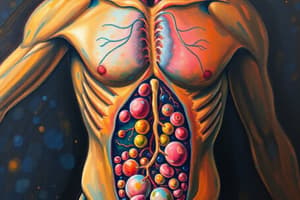Podcast
Questions and Answers
What is a key difference between prokaryotic and eukaryotic cells?
What is a key difference between prokaryotic and eukaryotic cells?
Eukaryotic cells are more primitive than prokaryotic cells.
Eukaryotic cells are more primitive than prokaryotic cells.
False (B)
What organelles are typically found in eukaryotic cells but not in prokaryotic cells?
What organelles are typically found in eukaryotic cells but not in prokaryotic cells?
Endoplasmic reticulum, Golgi body, Mitochondria
The genetic material in prokaryotic cells is located in the _____ called the nucleoid.
The genetic material in prokaryotic cells is located in the _____ called the nucleoid.
Signup and view all the answers
Match the following features with the type of cell they are characteristic of:
Match the following features with the type of cell they are characteristic of:
Signup and view all the answers
What is the main function of the ribosomes in a cell?
What is the main function of the ribosomes in a cell?
Signup and view all the answers
The nucleus of a cell does not contain DNA.
The nucleus of a cell does not contain DNA.
Signup and view all the answers
What is the primary function of the lysosomes?
What is the primary function of the lysosomes?
Signup and view all the answers
The ___________ is the storage area of the cell.
The ___________ is the storage area of the cell.
Signup and view all the answers
Match the following cell structures with their functions:
Match the following cell structures with their functions:
Signup and view all the answers
Which type of endoplasmic reticulum is responsible for detoxifying lipids?
Which type of endoplasmic reticulum is responsible for detoxifying lipids?
Signup and view all the answers
Vacuoles in animal cells are larger than those in plant cells.
Vacuoles in animal cells are larger than those in plant cells.
Signup and view all the answers
What is the fluidity of the cell membrane due to?
What is the fluidity of the cell membrane due to?
Signup and view all the answers
The series of tunnels throughout the cytoplasm that transport proteins is called the ___________.
The series of tunnels throughout the cytoplasm that transport proteins is called the ___________.
Signup and view all the answers
Which statement best describes the function of the Golgi bodies?
Which statement best describes the function of the Golgi bodies?
Signup and view all the answers
Study Notes
Life Processes of a Cell
- Nutrition: Cells acquire food molecules essential for their functions.
- Digestion: Enzymes break down food into smaller, absorbable units.
- Absorption: Retains water and key minerals necessary for survival from the environment.
- Biosynthesis: Cells synthesize complex molecules necessary for structure and function.
Principal Parts of a Cell
- Cell Membrane: Semi-permeable barrier controlling substance movement, depicted as a fluid mosaic model, and can self-seal when damaged.
- Cytoplasm: Jelly-like substance where organelles float, maintaining their positions within the cell.
- Nucleus: Membrane-bound control center housing DNA; includes the nucleolus for ribosome production.
Endoplasmic Reticulum (ER)
- Function: Acts as the cell's transportation system, moving proteins and substances.
-
Types:
- Smooth ER: Lacks ribosomes, detoxifies lipids.
- Rough ER: Contains ribosomes for protein production and transport.
Ribosomes
- Function as the cell’s protein factories; essential for various cellular functions as all organelles are protein-based.
Golgi Bodies
- Process, package, and distribute proteins from the ER to different parts of the cell.
Vacuoles
- Serve as storage areas within cells; larger central vacuole in plants for water, food, and waste, while animals typically have smaller vacuoles.
Lysosomes
- Contain digestive enzymes to breakdown waste material, old organelles, and pathogens within plant and animal cells.
Mitochondria
- Known as the "powerhouses" of the cell, they generate energy through cellular respiration.
Prokaryotic vs. Eukaryotic Cells
- Prokaryotic Cells: Simple, smaller cells without a defined nucleus; contain DNA in a nucleoid region; typically unicellular.
- Eukaryotic Cells: Larger, complex cells with a defined nucleus and various organelles (like ER, Golgi bodies, mitochondria); can be unicellular or multicellular.
- Eukaryotic cells evolved from prokaryotic cells and share essential life processes such as growth, response to stimuli, and reproduction.
Studying That Suits You
Use AI to generate personalized quizzes and flashcards to suit your learning preferences.
Description
Explore the essential life processes of a living cell, including nutrition and digestion. This quiz delves into how cells transform energy and matter, forming the basis of cellular activities. Test your understanding of these vital functions and their importance to life.



